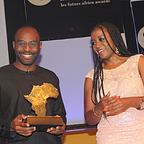Chronicles from #UNLEASHLAB2017: Day Two
Microsoft! made this day for me. Actually, no, that was the incredibly soft-spoken Alie Rose of Copenhagen Institute of Interaction Design (CIID). Or maybe it was the Labster guys at Rainmaking introducing many to VR and touring us through their virtual chemistry labs. The “panel debate” at the City Hall was a little wearying but it was an interesting topic on: “which big bet would you make on SDGS” — sounded like a very Dalberg-y thing.
Whichever way, I learned the following. My personal theme for this day has been DESIGN: simpler, more functional, less and accessible to a wider range.
At Microsoft:
- TV white spaces can be used for Wi-Fi internet connectivity. Why we didn’t know that before, I have no clue. OSAE, our government partner in Education for Lagos State through whom GEN is training 12,000 university students this summer would be interested in this. Turns out that type of Wi-Fi can go through two walls and they’ve achieved 50km of connectivity using the technology. Although cheaper, it’s not well known or utilised for less than noble reasons, says Sean (the global head of education)
- “Disability” is not a special problem. When we think of “accessibility,” we think Permanent disability (e.g. a person with one arm). Meanwhile, we can have Temporary disability (e.g. broken arm in cast) or even Situational disability (e.g. carrying a baby while working on a computer). An example Xi from China gave me: she bought her grandma an iPad. The old lady was using it late at night. Xi got up to use the bathroom and overheard the woman telling Siri “I don’t recognise your voice! Xi is that you speaking to me?” That’s situational disability. We should design so that Siri tells her, no I’m just a computer, not your granddaughter.
- Some of the key technologies we use to make our lives easier actually come from disability testing e.g. pinch zoom, eye control, etc. These technologies are then adapted to mainstream. Apparently Swedish Tobii, world leader in eye tracking tech will be rolling out with Windows 10 in the near future.
- Microsoft has got a slew of other tools: Eyegate; Me Translator; Office 365 is free for students (didn’t know); Global Educator Community (for teachers), etc. My only gripe is that they build these things and only they know about them!
At CIID
- Not everything needs to be on a screen. Why not design the smallest, most functional change that creates massive impact. e.g. a strip that helps kids express their emotions. Or a little self-learning non-screen device that knows when to open and shut a window. Or as I saw in the shower, a faucet that mechanically shuts off after 25 seconds.
- Design: between Osione, my friend/brand designer, and this lady Alie, they’ve made me fall in love with the concept. It’s a state of being.
At Rainmaking
- Storyboarding is an extremely powerful tool for developing VR content and the process of stakeholder engagement is interesting.
- I’ve developed relative familiarity with VR, thanks to my “work” at Imisi3D, so not much new but I did realize how well we can share content and collaborate. Even though Judith is doing a brilliant work creating the ecosystem of unity developers, etc., could we be even more efficient and focus on storyline development while we outsource dev there? Or vice versa…?
When they say “people from 129 countries,” it typically means nothing to me. Until I realise I share a room with a kind-hearted Macedonian guy, have lunch with a spritely Bhutanese woman, frequently discuss SME entrepreneurship in Southwest China with a thoughtful woman from Hong Kong, and teacher absenteeism in Myanmar with my Chinese friend who works there. It’s mind-boggling.
Like any typical conference, you spend your entire time repeating what you do, where you’re from, etc. But I remember clearly speaking to Aaron (India) and later Lawrence (Denmark) and they completely shifted my paradigm in two different ways. Aaron, a young entrepreneur who’s just gotten acquired asked so many refining questions about the SkillNav model we tested in Zest that I blanked out for a minute, from the weight of realisation of the sheer NUMBER of ASSUMPTIONS I’d taken for granted.
In his case, Lawrence gave me these words, “Learning is purpose-driven.” These words exactly encapsulate my whole ethos/problem frame:
- Forget school, make tertiary education a full time job!
- Inspiration, discovery of possibilities (e.g. careers) and mentorship are possibly the biggest gap in skills based learning.
Thoughts from today:
- What’s the potential role of Artificial Intelligence in predicting the success of an employee from Day 1?
- Azure Cloud for SkillNav (Africa lady), AVDD?
- Potential hackathon on VR for Zest learning? Will speak to Hamada of 412labs.com
